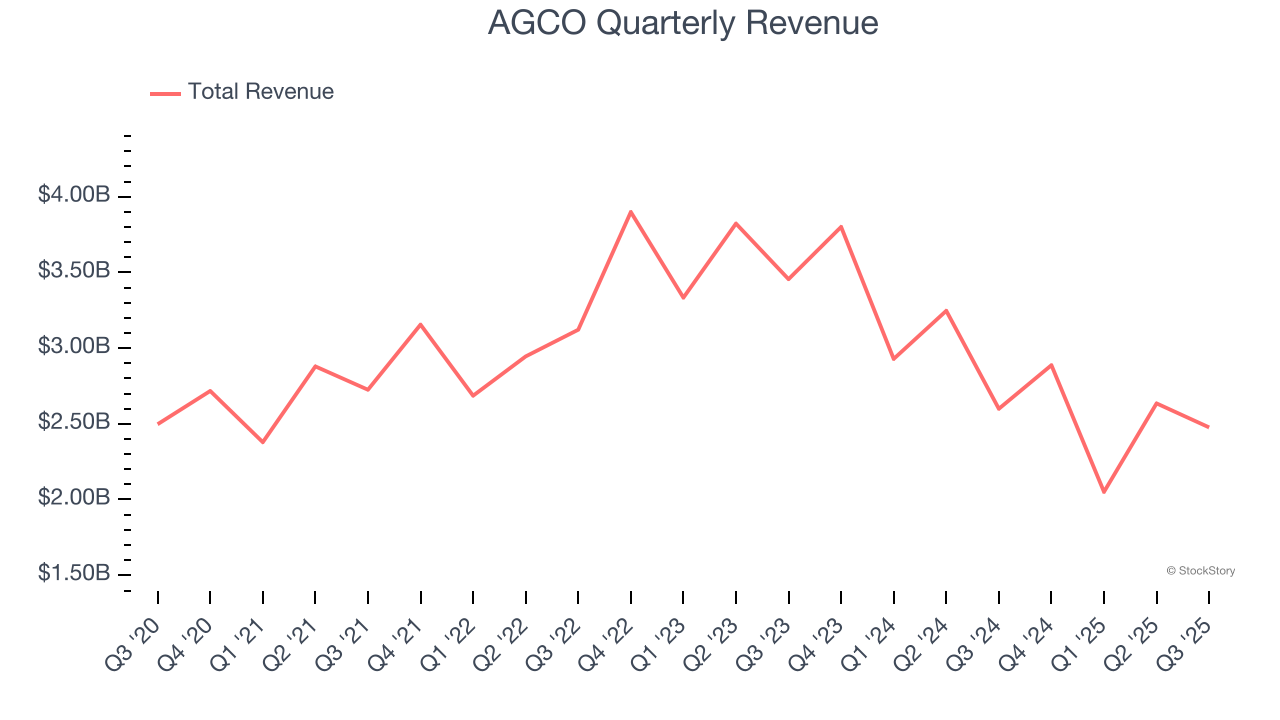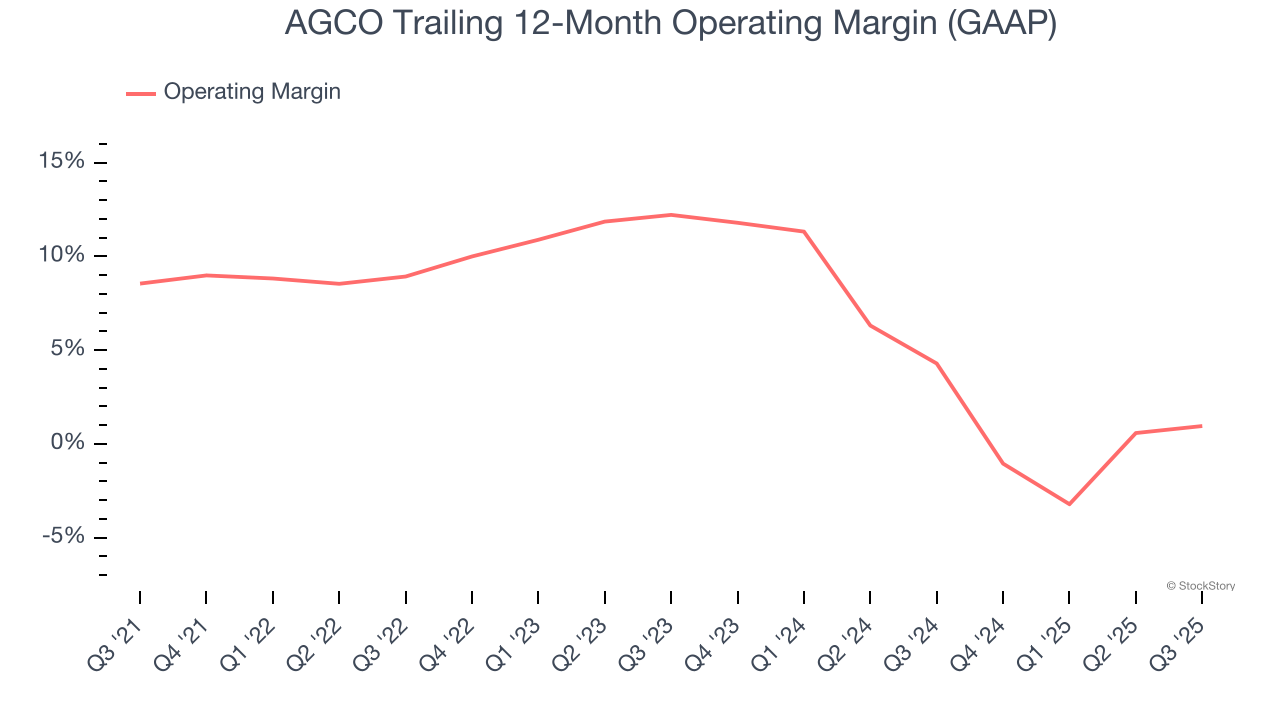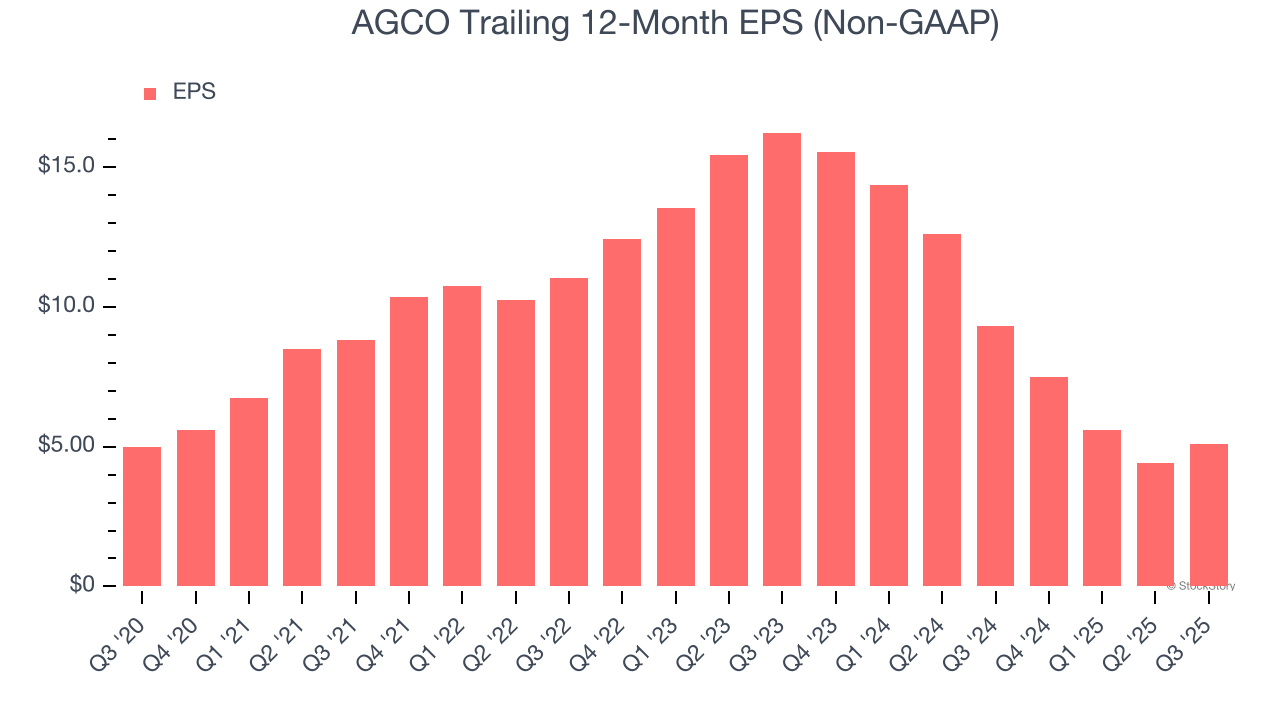
Agricultural and farm machinery company AGCO (NYSE: AGCO) fell short of the markets revenue expectations in Q3 CY2025, with sales falling 4.7% year on year to $2.48 billion. The company’s full-year revenue guidance of $9.8 billion at the midpoint came in 0.5% below analysts’ estimates. Its non-GAAP profit of $1.35 per share was 11.1% above analysts’ consensus estimates.
Is now the time to buy AGCO? Find out by accessing our full research report, it’s free for active Edge members.
AGCO (AGCO) Q3 CY2025 Highlights:
- Revenue: $2.48 billion vs analyst estimates of $2.49 billion (4.7% year-on-year decline, 0.5% miss)
- Adjusted EPS: $1.35 vs analyst estimates of $1.22 (11.1% beat)
- The company reconfirmed its revenue guidance for the full year of $9.8 billion at the midpoint
- Adjusted EPS guidance for the full year is $5 at the midpoint, beating analyst estimates by 4%
- Operating Margin: 6.1%, up from 4.4% in the same quarter last year
- Free Cash Flow was $2.1 million, up from -$59.8 million in the same quarter last year
- Market Capitalization: $7.92 billion
"AGCO delivered another solid quarter of navigating a complex global landscape shaped by challenging farm economics, high interest rates, and cautious capital investment," said Eric Hansotia, AGCO's Chairman, President and CEO.
Company Overview
With a history that features both organic growth and acquisitions, AGCO (NYSE: AGCO) designs, manufactures, and sells agricultural machinery and related technology.
Revenue Growth
Examining a company’s long-term performance can provide clues about its quality. Any business can put up a good quarter or two, but the best consistently grow over the long haul. Over the last five years, AGCO grew its sales at a sluggish 2.4% compounded annual growth rate. This was below our standards and is a tough starting point for our analysis.

Long-term growth is the most important, but within industrials, a half-decade historical view may miss new industry trends or demand cycles. AGCO’s performance shows it grew in the past but relinquished its gains over the last two years, as its revenue fell by 16.8% annually. AGCO isn’t alone in its struggles as the Agricultural Machinery industry experienced a cyclical downturn, with many similar businesses observing lower sales at this time. 
This quarter, AGCO missed Wall Street’s estimates and reported a rather uninspiring 4.7% year-on-year revenue decline, generating $2.48 billion of revenue.
Looking ahead, sell-side analysts expect revenue to remain flat over the next 12 months. Although this projection indicates its newer products and services will fuel better top-line performance, it is still below average for the sector.
Here at StockStory, we certainly understand the potential of thematic investing. Diverse winners from Microsoft (MSFT) to Alphabet (GOOG), Coca-Cola (KO) to Monster Beverage (MNST) could all have been identified as promising growth stories with a megatrend driving the growth. So, in that spirit, we’ve identified a relatively under-the-radar profitable growth stock benefiting from the rise of AI, available to you FREE via this link.
Operating Margin
Operating margin is an important measure of profitability as it shows the portion of revenue left after accounting for all core expenses – everything from the cost of goods sold to advertising and wages. It’s also useful for comparing profitability across companies with different levels of debt and tax rates because it excludes interest and taxes.
AGCO was profitable over the last five years but held back by its large cost base. Its average operating margin of 7.3% was weak for an industrials business. This result isn’t too surprising given its low gross margin as a starting point.
Analyzing the trend in its profitability, AGCO’s operating margin decreased by 7.6 percentage points over the last five years. This raises questions about the company’s expense base because its revenue growth should have given it leverage on its fixed costs, resulting in better economies of scale and profitability. AGCO’s performance was poor no matter how you look at it - it shows that costs were rising and it couldn’t pass them onto its customers.

In Q3, AGCO generated an operating margin profit margin of 6.1%, up 1.7 percentage points year on year. Since its gross margin expanded more than its operating margin, we can infer that leverage on its cost of sales was the primary driver behind the recently higher efficiency.
Earnings Per Share
We track the long-term change in earnings per share (EPS) for the same reason as long-term revenue growth. Compared to revenue, however, EPS highlights whether a company’s growth is profitable.
AGCO’s flat EPS over the last five years was below its 2.4% annualized revenue growth. This tells us the company became less profitable on a per-share basis as it expanded.

We can take a deeper look into AGCO’s earnings to better understand the drivers of its performance. As we mentioned earlier, AGCO’s operating margin expanded this quarter but declined by 7.6 percentage points over the last five years. This was the most relevant factor (aside from the revenue impact) behind its lower earnings; interest expenses and taxes can also affect EPS but don’t tell us as much about a company’s fundamentals.
Like with revenue, we analyze EPS over a more recent period because it can provide insight into an emerging theme or development for the business.
For AGCO, its two-year annual EPS declines of 44.1% show its recent history was to blame for its underperformance over the last five years. These results were bad no matter how you slice the data.
In Q3, AGCO reported adjusted EPS of $1.35, up from $0.68 in the same quarter last year. This print easily cleared analysts’ estimates, and shareholders should be content with the results. Over the next 12 months, Wall Street expects AGCO’s full-year EPS of $5.08 to grow 18.1%.
Key Takeaways from AGCO’s Q3 Results
We were impressed by AGCO’s optimistic full-year EPS guidance, which blew past analysts’ expectations. We were also glad its EPS outperformed Wall Street’s estimates. On the other hand, its revenue slightly missed and its full-year revenue guidance fell slightly short of Wall Street’s estimates. Overall, this print was mixed but still had some key positives. The stock traded up 4.5% to $110.91 immediately after reporting.
Indeed, AGCO had a rock-solid quarterly earnings result, but is this stock a good investment here? If you’re making that decision, you should consider the bigger picture of valuation, business qualities, as well as the latest earnings. We cover that in our actionable full research report which you can read here, it’s free for active Edge members.




